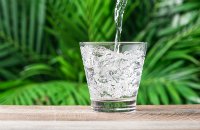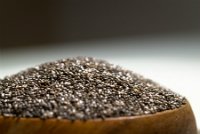MAY 2017
WHAT’S NEW
H2O: ELIXIR OF HEALTH & VITALITY
Water. We can’t live without it. Literally. It comprises about 70% of adult body weight and even more for infants and children.
Essential to every cell in the body, water helps to . . .
- Maintain normal temperature through sweating and respiration
- Regulate thirst and appetite
- Transport nutrients in the bloodstream
- Remove waste and toxins through urination, perspiration, and bowel movements
- Reduce friction in joints and facilitate muscle contraction
- Balance pH level (acid and alkaline)
- Nourish the skin

8 x 8: IS THAT REALLY ENOUGH WATER FOR YOU?
Everyone’s hydration needs are different, depending upon age, gender, activity level, body composition, and overall health. It’s more myth than scientific fact that healthy people should drink 8 cups x 8 ounces of water daily. A better estimate is your body weight: Drink one-half ( ½) your weight in ounces. For example, if you weigh 130 pounds, drink 65 ounces of water each day.
YOUR BODY NEEDS MORE WATER WHEN YOU:
• Are in hot, dry climates or at high altitudes
• Exercise or perform rigorous work
• Take certain medications
• Are pregnant or breastfeeding
• Feel ill – running a fever, experiencing diarrhea or vomiting; during acute and chronic injury/illness
WHAT COUNTS AS WATER?
Pure H2O is best. Caffeine-free tea, such as herbal, can count toward daily fluid intake. Coffee and fruit juice don’t contribute to hydration. Food, such as celery, tomatoes, cucumber and melons, may contribute to daily water requirement depending on the proportion of fruits and vegetables in your diet, however, it is not the preferred water when some foods are higher in sugar content.
ARE YOU DEHYDRATED?
Dehydration means your body lacks the water required to function. Many people are in a chronic state of insufficient hydration. This can result in constipation, dry skin, inflammation, urinary tract infections, fatigue, and weight gain due to increased appetite.
Inadequate hydration makes it harder for the body to eliminate toxins and can quickly lead to acute dehydration, which is life threatening. Warning signs include dry mouth, irritability, headaches, and muscle cramps. If you don’t receive fluids, you become dizzy, clumsy and exhausted. The vital organs start shutting down. Without water, you will enter into a coma and die.
You may have heard you can determine if you are dehydrated by the color of your urine. However, certain foods, supplements, and medications change urine color, so it’s not a reliable guide. Your health practitioner can help you determine the amount of water that’s right for you.
SAVVY WAYS TO DRINK MORE WATER
- Use a “dedicated” glass or water bottle. Choose a style and size that feels right to you. Keep it by your side and sip it throughout the day. Our favorite water bottles include the beautiful BKR glass and silicone bottles. Another favorite of ours is the Hydro Flask.
- Do the citrus twist. Embellish water with slices of orange, lemon, or lime. Our favorite is adding fruits like sliced strawberries, lemon and mint.
- Get fizzy. Bubbly spring water hits the spot on a hot day. Look for carbonated water without added sweetener. Search online for recipes for making your own carbonated ginger or lemon-lime beverages. You can always add a shot of organic ginger juice to a glass of sparkling water, it’s delicious!
- Enjoy Virgin Sangria (or Earth Juice for kids). Pour water over fresh (or frozen) citrus, melon, blueberries or strawberries. Chill for a few hours. The water extracts some of the flavor, nutrients and color. Try with mixed fruits or carbonated water for a delicately sweetened, beautiful refreshment.
- Dilute your alcohol. We know this sounds a bit crazy yet we’ve been practicing it for years. Instead of ordering another alcoholic beverage when you are out with your friends or at business dinners, add sparkling or still water to your beverage when you have a 1/4 left in your glass. This method keeps you hydrated and prevents you from becoming intoxicated.
FOOD FOR THOUGHT. . .
Always laugh when you can. It is cheap medicine.” – Lord Byron
CHIA SEEDS: TINY POWERHOUSE

It’s simple to add Chia seeds to your diet. Since the seeds are bland, you can add them to just about any dish or beverage without changing its flavor. Mix chia into cereal, oatmeal, pudding, or yogurt, or blend into a smoothie. Chia seeds can be soaked in juice and added to baked goods. Also, you can eat raw seeds. If you’re new to chia, start with about one tablespoon a day until you get used to the fiber content. A typical serving is 1.5 tablespoon twice a day, or about 20 grams.
RECIPE: PEACH-SPINACH CHIA SMOOTHIE

1 1/2 c. frozen peaches
1 c. apple juice (juicing your own is best)
1/2 c. water
2 T. chia seeds
1 1/2 c. baby spinach leaves
Combine the peaches, apple juice, water, chia seeds, and spinach leaves in a blender; puree until smooth, about one minute. Serve immediately.
Photo and Recipe Credit: Real Simple.
TRACE MINERALS: ESSENTIAL TO A HEALTHY BODY

There was a time when non-processed foods, like dark leafy greens (and others), provided all the minerals we need. But today, that’s not the case. According to The US Department of Agriculture and other researchers our food remains relatively stable in terms of vitamins but deficient in minerals, particularly trace minerals, which we need for optimal health.
Symptoms of mineral deficiencies are varied and can surface at any time.
They can include:
- GI issues: constipation, bloating, diarrhea, poor digestion
- Poor immune function
- Impaired cognitive function: memory, learning, brain fog
- Muscle issues: pain, spasms, cramping, weakness
- Heart issues
- Generalized pain, weakness or fatigue
- Developmental delays or behavioral issues
So, how do we address this dilemma? Eat healthy, non-processed foods, especially dark leafy greens, vegetables, fruit, nuts, legumes and lean proteins. Supplement with a good quality multiple vitamin and mineral formula (macrominerals) and use a separate trace mineral formula. Trace minerals are acquired from the mineral rich waters found in certain oceans and seas around the globe such as the Great Salt Lake and the Australian Ocean. They can also be plant-derived. These can be taken as a capsule, liquid, powder and even added to your water. Your holistic health practitioner can test your mineral levels should they suspect a deficiency or imbalance. They can also guide you regarding the best product and dose.
STINGING NETTLE (Urtica dioica)

If cooked leafy greens aren’t your favorite, you can still reap the health benefits of Stinging Nettle. For instance, to enjoy a cup of Stinging Nettle tea, steep 2 tablespoons of crushed dried leaves or look for tea bags. Capsules, tablets, extract and and tinctures are also available. Whether as a food, beverage, or herbal supplement, Nettle is a safe herb for most adults, with the exception of women who are pregnant or nursing.
Our favorite stinging nettle product is HISTAWAY and mixed with Vitamin C for the best anti-inflammatory effect. HISTAWAY is perfect for seasonal allergies and works wonders. Check with your holistic health practitioner about the best way to add this amazing herb to your diet.
HEALTH BENEFITS OF FILTERED WATER

WHY FILTER YOUR WATER?
Over 2,100 known toxins may be present in drinking water, which increases your risk for illness and affects the taste and smell of water. Better tasting, better smelling, and healthier water is what you get when you filter out chemical (e.g., chlorine/ lead) and bacterial contaminants from the water you drink or use for bathing. This also reduces the risk of rectal, colon and bladder cancer, as well as gastrointestinal and autoimmune illness. The EPA recognizes the benefit of filtered water for individuals with chronic illness or compromised immune systems.
It is said that birth control pills especially are very difficult to filter out of the water system. In the Potomac river in Washington, D.C., androgenous fish have been found.
Familiarize yourself with the following articles:
http://news.nationalgeographic.com/news/2007/05/070521-sex-fish.html
http://www.npr.org/templates/story/story.php?storyId=6082152
WAYS TO FILTER YOUR WATER
Before you purchase any filtration system, learn about the quality of your household water supply by reading your water utility company’s “Consumer Confidence Report.” By law, all homeowners are to receive this in the mail by July 1 of each year. The report (also found online) details where your drinking water comes from, which contaminants have been found in it, and how contaminant levels compare to national standards. Next, have the water directly supplied to your house sampled and tested by a state-certified lab (also listed online). Together, these two steps will identify the most significant water supply concerns at your residence.
The chemical and/or bacterial contaminants filtered out vary by brand and model of filtering system. Learn as much as possible before purchasing a system for your home or personal use.
Countertop / personal use filters are placed in a pitcher or water bottle. These are inexpensive but typically only filter out lead/chlorine. More intricate systems, such as those used for camping, can filter out some types of bacteria and other contaminants.
Point-of-entry filters are installed at the main water line to your home. Point-of-use filters are affixed to a faucet or showerhead or at the plumbing line below the sink. Depending on the system, these can remove lead and other contaminants.
Ion Exchange Filters (aka Water Softeners) remove dissolved salts and other minerals that create chemically “hard water.” These filters soften water by exchanging naturally-forming mineral ions with its own ions to neutralize the harmful effect of mineral build-up in pipes, which alters the quality of your household water.
Granular Carbon/ Carbon Block Filters use a chemical or physical bonding process that pulls contaminants to the surface of the filter. Granular systems are best for removing organic chemicals such as herbicides, pesticides and industrial chemicals. A caveat with granular filters: loose material can form channels that trap water which then escapes proper filtering. Carbon block filters compress the carbon medium, eliminating channeling and providing more precision for filtering a wider range of contaminants.
Reverse Osmosis (RO) Filters force water through a membrane that draws out organic and inorganic contaminants. RO uses three times as much water as is treated but it is most effective in eliminating all disease-causing organisms and most chemical contaminants. Minerals are lost during RO so you must add trace minerals to the water or take a trace mineral supplement.
Alkaline Water Systems. You may be hearing a lot about pH alkaline water systems or bottled alkaline water. This system concentrates mineral content (it does not filter it) and some health scientists propose alkaline water can neutralize acid in the body, which is good for health. A variety of factors have to be considered when looking at the role of alkaline water in maintaining good health or supporting treatment for certain conditions. Natural spring water from the ground can have a pH of 5.5, which is not alkaline. Also, when you consume alkaline water, make sure it is away from food- you need your acids and enzymes to digest food.
Determining which filtering system is best for you depends upon where you live, the size of your home, your family’s health concerns, and your budget. Look for a filter that is certified using ANSI/ISF standards, such as NSF International, Underwriters Laboratories, and Water Quality Association). Also look for recommendations from the Environmental Working Group (EWG). Talk with your health practitioner about your local water supply, environmental issues, and personal needs.
Lastly, if you are a water junkie like us, check out Find A Spring for a natural spring water location near you. We drive to MD which is a good hour away from our house every few weeks to fill our 19 liter BPA-free jugs with natural spring water. Nothing in life beats natural spring water.
H2O ELIXIR OF HEALTH & VITALITY REFERENCES
- Popkin, Barry M., Kristen E. D’Anci, and Irwin H. Rosenberg. “Water, Hydration and Health.” Nutrition reviews 68.8 (2010): 439–458. PMC. Web. 8 Mar 2017.
- Jequier E, Constant F. “Water as an essential nutrient: the physiological basis of hydration.” Eur J Clin Nutr. (2010) 64:115–123. 8 Mar 2017.
- Murray, B. “Hydration and Physical Performance.” J Amer Coll of Nutrition (2007 Oct 26) [5 Suppl] 542S-548S. Accessed 8 Mar 2017.
- USGS.gov. “The Water in You.” Accessed 8 Mar 2017.
- Heinz V., “Drink at least eight glasses of water a day.” Really? Is there scientific evidence for “8 × 8″?”Amer J Physio – Regulatory, Integrative and Comparative Physiology (1 November 2002). 283:5, R993-R1004 DOI: 10.1152/ajpregu.00365.2002 Accessed 8 Mar 2017.
- Long, M. “Sports Performance and Nutrition: A Comprehensive Guide.” Naturopathic Currents. (2015 April – Web). Accessed 8 Mar 2017.
- HealthyEating.SFGate.com. “Why do we need to drink water?” Accessed 8 Mar 2017.
- Project Wet (resource for grades 8 through 12) Accessed 8 Mar 2017.
CHIA SEEDS: TINY POWERHOUSE REFERENCES
- WorldsHealthiestFoods.com. “Chia or Flax Seeds: Which is preferable as an addition to meals?” Accessed 1 Mar 2017:
- Nieman, D.C., Gillitt, N., Jin, F., et al., “Chia Seed supplementation and disease risk factors in overweight women: A metabolomics investigation.” The Journal of Alternative and Complementary Medicine. July 2012, 18(7): 700-708. doi:10.1089/acm.2011.0443.
- “Phytochemical profile and nutraceutical potential of chia seeds (Salvia hispanica L.) by ultra high performance liquid.” J Chromatography A (2014) 1346: 43-48. Accessed 1 Mar 2017.
- BetterNutrition.com “Super Seeds” (May 2012) Accessed 1 Mar 2017: http://www.betternutrition.com/chia-seeds/
- AuthorityNutrition.com. “11 Proven Benefits of Chia Seeds.” Accessed 1 Mar 2017.
TRACE MINERALS: ESSENTIAL TO A HEALTH BODY REFERENCES
- McCormick, Donald B. “Vitamin/Trace Mineral Supplements for the Elderly.” Advances in Nutrition 3.6 (2012): 822–824. PMC. Web. 2 Mar. 2017.
- SFGate.com. Healthy Eating: List of Trace Minerals. Accessed 2 Mar 2017.
- ConcenTrace Minerals Product Information
- Davis, D.R. “Declining Fruit and Vegetable Nutrient Composition: What Is the Evidence?” Hortscience. 44.1 (2009): 15-19. Print.
- Welch, RM, and RD Graham. “Breeding for Micronutrients in Staple Food Crops from a Human Nutrition Perspective.” Journal of Experimental Botany. 55.396 (2004): 353-64. Print.
STINGING NETTLE REFERENCES
- University of Maryland Complementary and Alternative Medicine Database. “Stinging Nettle.” Accessed 1 Mar 2017.
- HerbWisdom.com. “Nettle (Urtica Dioica): Stinging Nettle Benefits.” Accessed 1 Mar 2017.
- Drexel.edu. “Clinical Applications of Stinging Nettle.” (Aug 2012). Accessed 1 Mar 2017.
- Johnson TA, Sohn J, Inman WD, et al., “Lipophilic stinging nettle extracts possess potent anti-inflammatory activity, are not cytotoxic and may be superior to traditional tinctures for treating inflammatory disorders.” Phytomedicine. (2013) 20:143-7. Accessed 1 Mar 2017.
- Koch E. “Extracts from fruits of saw palmetto (Sabal serrulata) and roots of stinging nettle (Urtica dioica): viable alternatives in the medical treatment of benign prostatic hyperplasia and associated lower urinary tract symptoms.” Planta Med. (2001) 67:489-500. Accessed 1 Mar 2017.
- OrganicFacts.net. “Health Benefits of Stinging Nettle.” Accessed 1 Mar 2017.
HEALTH BENEFEITS OF FILTERED WATER REFERENCES
- Water Supply Reports and Testing:
Consumer Confidence Report
State Water Testing Labs - EPA.gov. “Water Health Series: Filtration Facts.” Accessed 5 Mar 2017. /2005_11_17_faq_fs_healthseries_filtration.pdf
- University of Nebraska at Lincoln: “NEB Guide: Drinking Water Treatment- Ion Exchange (Water Softening).” Accessed 24 Mar 2017.
- WellnessMama.com. “Water Filter Options.” Accessed 5 Mar 2017.
- Science.HowStuffWorks.com. “Reverse Osmosis.” Accessed 5 Mar 2017.
- EWG.org. “Finding a Water Filter that Works for You.” Envrionemntal Working Group (4 Mar 2013) Accessed 6 Mar 2017.
- DES.NH.Gov. Scientific Fact Sheet: Ion Exchange of Drinking Water. Accessed 24 Mar 2017.
- Magro, Massimiliano et al. “Alkaline Water and Longevity: A Murine Study.” Evidence-based Complementary and Alternative Medicine : eCAM 2016 (2016): 3084126. Accessed 24 Mar 2017.
- REI.com. Water Filters and Purifiers (Camping related).
- “Staying Hydrated All year Long.” Posted by Ralph Morris, MD, MPH. (7 Mar 2014) Accessed 6 Mar 2017.
- “Water Treatment Fundamentals.” Posted by Water Quality & Health Council. (6 Aug 2013). Accessed 6 Mar 2017.
- Water Filtration Glossary of terms.
- KidsHealth.org. “Why Drinking Water is the Way to Go.” Accessed 6 Mar 2017.
GUIDING PRINCIPLES

First Do not Harm

Identify and Treat the cause

Healing Power of Nature

Doctor as Teachers

Treat the Whole

Prevention is best Medicine
Follow us on instagram
BLOG
Become an educated consumer with our Indigo Blogs and prevent dis-ease.
Our Doctors have been featured in:









